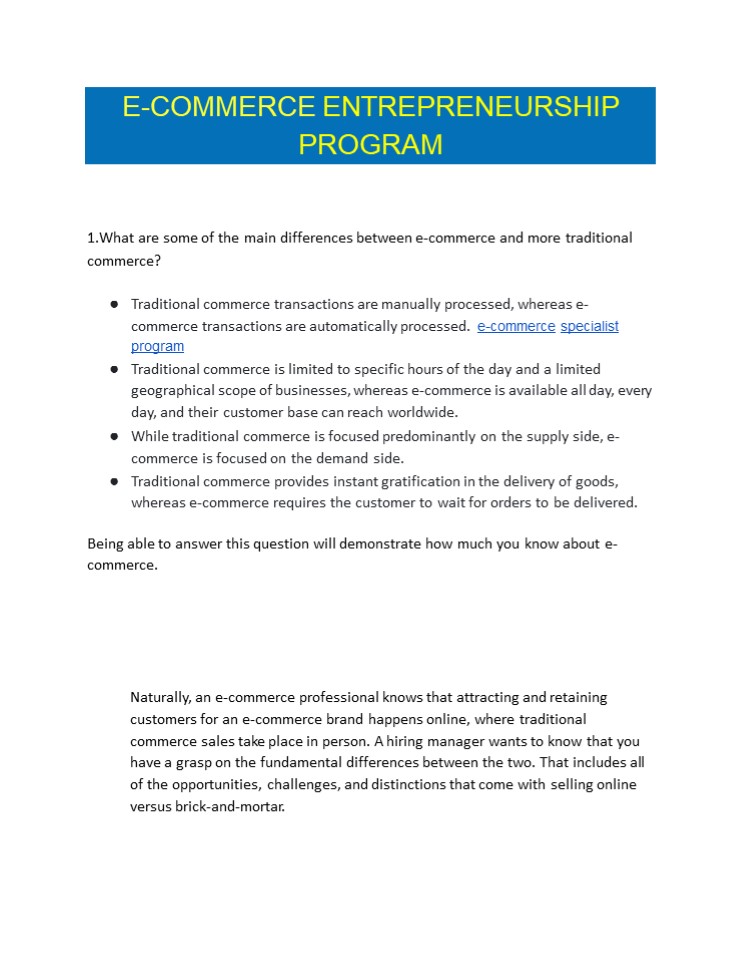E-COMMERCE ENTREPRENEURSHIP PROGRAM - PowerPoint PPT Presentation
Title:
E-COMMERCE ENTREPRENEURSHIP PROGRAM
Description:
1. What are some of the main differences between e-commerce and more traditional commerce? Traditional commerce transactions are manually processed, whereas e-commerce transactions are automatically processed. e-commerce specialist program Traditional commerce is limited to specific hours of the day and a limited geographical scope of businesses, whereas e-commerce is available all day, every day, and their customer base can reach worldwide. While traditional commerce is focused predominantly on the supply side, e-commerce is focused on the demand side. – PowerPoint PPT presentation
Number of Views:1
Title: E-COMMERCE ENTREPRENEURSHIP PROGRAM
1
E-COMMERCE ENTREPRENEURSHIP PROGRAM
- What are some of the main differences between
e-commerce and more traditional commerce? - Traditional commerce transactions are manually
processed, whereas e- commerce transactions are
automatically processed. e-commerce specialist
program - Traditional commerce is limited to specific hours
of the day and a limited geographical scope of
businesses, whereas e-commerce is available all
day, every day, and their customer base can reach
worldwide. - While traditional commerce is focused
predominantly on the supply side, e-commerce is
focused on the demand side. - Traditional commerce provides instant
gratification in the delivery of goods, whereas
e-commerce requires the customer to wait for
orders to be delivered. - Being able to answer this question will
demonstrate how much you know about e-commerce.
Naturally, an e-commerce professional knows that
attracting and retaining customers for an
e-commerce brand happens online, where
traditional commerce sales take place in person.
A hiring manager wants to know that you have a
grasp on the fundamental differences between the
two. That includes all of the opportunities,
challenges, and distinctions that come with
selling online versus brick-and-mortar.
2
2. Can you mention and describe a few models? To
help you answer this question, try filling in the
blanks in this hypothetical statement I have
blank years of experience in the blank
industry doing blank, but my personal
experience as a consumer has compelled me to want
to create better experiences for the DTC space.
Heres an example of that experience. Ecommerce
hiring managers are asking this question to
understand how well you understand the
e-commerce industry. There are a ton of different
models that they could be referring to, from
omnichannel to https//www.skillshiksha.com/ecomme
rce-specialist-program. This is a great
opportunity for you to speak about your
experience, both professionally and what youve
seen or read online. Perhaps you have years of
https//www.skillshiksha.com/ecommerce-specialist-
program, but youre applying as an e-commerce
marketer for a B2C online retailer. Help the
hiring manager understand that you understand how
marketing strategies differ in e-commerce.
3. What are some key metrics to track in any
e-commerce model? Pick a few metrics youre
familiar with and have experience measuring. For
instance, If youre in social media marketing,
talk about hitting numbers for reach, engagement,
and CPC (cost per click). If youre an email
marketer, speak to optimizing email
click-throughs, open rates, and list
segmentation. The more you can speak to metrics
directly related to e-commerce, the better. These
metrics include average order value (AOV),
customer lifetime value (CLV), and repeat
customer rate. E-commerce is still commerce, so
selling products is the end goal, as it always
has been. Especially when it comes to selling
products online, sales can come from
3
- efforts across many channels (hence the popular
term omnichannel'), so having basic to advanced
knowledge of what those channel metrics are and
how to set KPIs for each channel is imperative. - In the e-commerce marketing role, some of those
include - Customer acquisition cost (CAC)
- ROAS (return on advertising spend)
- Email and SMS open and click-through rates
- Customer retention
- What do you think are some of the disadvantages
of e-commerce as a business model? - In short, make ecommerce the hero of the story.
- So many brands, particularly in the DTC space as
of late, have made their online-only platform
work for them. For instance, Casper mattresses
(back when they were 100 e-commerce-led) allowed
customers a 100-night sleep test with a
money-back guarantee. - Pull from popular e-commerce brands as examples
and showcase why e- commerce doesnt have to feel
like a simple transaction. - You can expect this question from a company that
wants to see your thought process for solving
some of the challenges of e-commerce. Some of the
challenges include the option to interact with
the product before purchasing privacy and
security concerns and the inability to create a
brand-centric, in- person buying experience. - We notice that customer churn is on the rise how
would you boost repeat purchase rates and
increase customer retention?
4
Nows a good time to share your experience on how
to retain customers. Briefly walk them through
the problem, the strategy, and the outcome. Be
sure to state what KPIs you measured and the
tools you used to succeed. If you dont have
relevant experience growing customer retention
rates, thats okay, too. Find an opportunity in
their current marketing strategy and offer it
up as a suggestion, such as creating a blog with
articles related to the product and/or brand or
how you would improve the brands marketing
emails. Offering actionable ways you can help
improve the brands marketing strategy can help
show the hiring manager the value you can bring
to the table. Ecommerce hiring managers want to
see that you already have a plan for improving
key metrics before youve even stepped in the
door. Or, at least, have a solid way to think
through core problems and get things done to test
and improve metrics. Does the plan have to be
entirely successful? Of course not! But to land a
job as an e-commerce professional, you need at
least a basic understanding of the customer
mindset. This involves knowing ways to scale the
customer experience and leverage both new and
existing channels to drive results.





















![Courses After 12th Commerce for Girls [2022] | Academy Tax4wealth PowerPoint PPT Presentation](https://s3.amazonaws.com/images.powershow.com/9790676.th0.jpg?_=20220816015)









